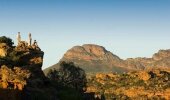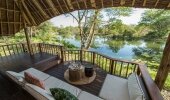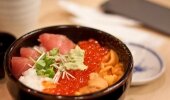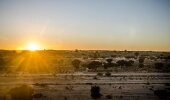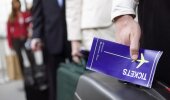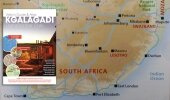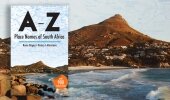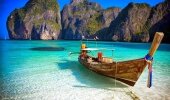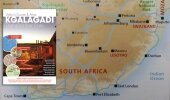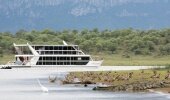Words & photos by Xen & Adri Ludick
Embarking on the final leg of our journey, my feelings were mixed. Sad that we would soon be leaving this incredible and wild wonderland, but happy to be returning home to share our memories and photos with family and friends. Xen and I had now travelled 3700km in three weeks and our homeward journey would see us leaving Epupa Falls and heading to Purros, then Palmwag via the Orange Drum, through Botswana and all the way home to Kyalami.
From Epupa Falls we travelled south to Okongwati, then took the scenic route to Entengwa, past Otjitanda and stopped to camp at Marble Campsite, a community campsite run by the Orupembe Conservancy. The road was terrible and we were in total agreement when the GPS indicated 'not recommended route'. The road was so bad that I had to get out of the vehicle on numerous occasions to direct Xen over and past many obstacles. We later heard that some other travellers in a Land Rover had to winch themselves up certain hills – luckily we have a Land Cruiser J! Kaokoland, part of the Kunene region, lies east of the rugged, forbidding Skeleton Coast Park; a region of rocks, fog, shipwrecks and desolation, washed by the waters of the Benguela current that brings Antarctic cold to desert heat. Kaokoland is one of Namibia’s most scenic regions, with its beautiful landscape of tabletop mountains, cone-shaped hills and rock-strewn plains covered in colours of white, yellow, brown, ocher and - luckily for us after the rainy season – brilliant green.
Leaving the campsite early the next day we travelled north, traversing the rocky Hartmann’s Pass to Red Drum, a memorial to Jan Joubert and a major intersection in the middle of nowhere, then past the Blue Drum with its humorous telephone and dish saying, 'Due to load shedding no signal', and Orange Drum. In this incredibly remote area we saw lots of animals. This mystic, picturesque landscape with its many facets and amazing wild life far exceeded my expectations and no canvas or photo could ever capture its true essence. Travelling along the border of the Skeleton Coast National Park we saw the mysterious 'fairy circles' that continue to leave scientists baffled. Some people speculate about visitors from outer space, while others argue it to be termites. We camped at Ngatutanga Camp at Purros, one of the best known semi-permanent Himba settlements, and it's so beautiful that you immediately have the desire to stay for longer. The bathrooms and kitchen wash-up areas are built in the trees at each campsite to protect them from the elephants, which we heard grazing around our roof tent that night.
The next morning we crossed the Hoarusib River and came across a very aggressive desert elephant that proceeded to chase us. I couldn’t believe it as this was now the third time we'd been charged on the same trip! We continued on through many riverbeds and past a continuously changing landscape to Sesfontein, named after the six springs that surface nearby and it marks the northern edge of Damaraland. When the map warns you about dry riverbeds, soft mud and fine dust, take note and be careful. Sesfontein had no fuel so we had to push on another 82km to Palmwag to refuel. We decided to camp at the Palmwag Lodge and later that night as we were dining in the restaurant our waiter told us fascinating stories about 'Sebastiaan', the old desert dwelling elephant, and 'Chris' with one tooth.
Damaraland lies adjacent to the National West Coast Recreation Area and is known for its majestic flat-topped mountains, spectacular gorges, wide open plains and art treasures. About 30km before Khorixas, we turned south to Aba-Huab to view the famed Organ Pipes and Burnt Mountain. The Organ Pipes consist of a series of dolomite pillars that have been exposed by erosion. Burnt Mountain gets its name from the piles of blackened stone at its base; chunks of black dolerite combined with rocks in an amazing variety of colours to create the impression that the mountain has been burnt by a fierce fire. Avoiding a rock monitor on the road between Palmwag and Twyfelfontein, we continued to Otjiwarongo and overnighted at the charming Waterberg Game Reserve.
The next day we crossed the border at Mamuno and turned south at Charles Hill to Kule. At Ncjogane we turned right and followed the road to the Ukwi Pan. It was getting dark and ominous black clouds warned us that rain was on its way. We passed a San village and about six kilometres outside the village, on a little hill, is what is supposed to be a campsite. In front of the campsite lies one of the largest pans in Botswana outside of the Makgadikgadi, and etched against the blackened sky was the green woodlands of Botswana. That night the heavens opened and from the shelter of our roof tent we watched the fireworks created by the electric storm.
As we were close to the end of our trip, we decided to treat ourselves and sleep in the next morning. However, just after sunrise we heard a voice, “More,” (good morning in Afrikaans). Emerging curiously from the tent I came upon a bushman crouched in front of the car. After bidding him good morning I asked whether he required any help. Not making any eye contact and gazing out over the flats of Botswana, he told me that he'd come to visit. Half sleepy and half amused I went back to the tent and told Xen that we had a visitor. A not-amused Xen said to tell him that if we gave him food, he must go away. More awake now I went back outside and asked him what he wanted, whereupon he told me that he, Saruti, had come to visit me and have tea. Well, that was all the encouragement I needed!
I immediately made a fire and started making food for him, just as Xen came to join us. Saruti moved closer to the fire and after I had offered him two bröchens (bread rolls), we started asking him questions. We asked if there were any leopards here and he said no, there were tigers here. We knew it was impossible as he described it as 'die bont-een-wat-laag-loop'! He told us that he couldn’t hunt anymore because he didn’t have money to purchase a permit. Enquiring if he could speak the San language, he replied that he could. He asked if I knew a particular farmer in Namibia as I closely resembled his daughter who spoke the San language, to which I replied that I was not the one he was referring to. Smoking a stainless steel pipe filled with cattle dung, he went on to tell us how he tans jackal skins for income. When Xen gave him a real cigarette he became very talkative, enjoying the cigarette and the moment. He only ate one bröchen and as I was about to throw the paper plate into the fire he stopped me and held on to the plate, touching it as if it was Royal Albert china. Only then did I realise how much the paper plate meant to him. As our visit came to an end I put the remaining bröchen into a zip lock bag along with a packet of sweets for his children. As Saruti left to walk the six kilometres back to his village, I was sorry that I hadn’t given him more and asked more questions.
Driving along the Ukwi Pan and past the Masetleng Pan we saw a Black Mamba for the second time on this trip, and a beautiful Eagle owl. By taking a road that hardly existed it took us four hours to drive the 124km to the KAA entrance gate to the Kagalagadi Transfrontier Park. The KAA campsites in the immediate area were fully booked, but we were allowed to sleep at the gate for a night. That evening we experienced another spectacular electric storm and watched as the lightning played around us.
The next morning we woke to a major storm resembling the movie Independence Day. Leaving in the rain, we drove to Hukuntsi where the most incredible blue grass of the area looked even bluer against the backdrop of the storm. All the animals at the pans stood with their backsides pointed in the direction of the rain, and we watched the young Blue wildebeest chasing each other around the pan while the springbuck jumped with excitement. Sitting there quietly, we were humbled by the greatness of the universe and so thankful that we could enjoy such a small part of it.
From Hukuntsi we headed towards to Kokong via Tshane and saw a huge Puff Adder lying next to the road. Hitting the Trans Kalahari Highway we proceeded to Jwaneng and crossed the border at Pioneer Gate / Skilpadshek. Now back in South Africa we headed for home.
December seems so far off, so we’ll just have to wait for the next adventure. Until then, safe travels.
